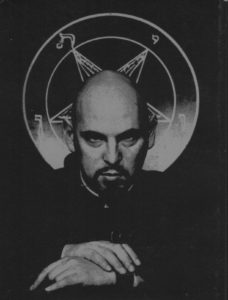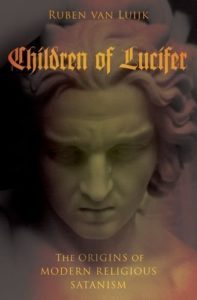“Satanism is not a part of Romanticism. It is Romanticism. It may well be said without any levity that Satan was the patron saint of the Romantic School. He impressed it with his personality to such an extent that it was soon named after him.”1
— Maximilian Rudwin, The Devil in Legend and Literature (1931)
Romantic Satanism—that grand turn-of-the-nineteenth-century tradition which proved to be a lodestone for some of the most titanic intellectuals, poets, prose writers, and visual artists of the Romantic Era—was the most significant cultural reappraisal of the figure of the fallen angel, and as such was the most radical challenge to the status quo in Western history. The Romantic Satanists championed the sympathetic and sublime Satan out of Milton’s Paradise Lost (1667) as a sociopolitical icon of idealized defiance, employing the Miltonic arch-rebel in their struggle against oppressive orthodoxy. Curiously, those within organized Satanism—that is, Satanism as codified as an aboveground, legally recognized religious or irreligious philosophy, which began with Californian “Black Pope” Anton LaVey’s Church of Satan in the 1960s—are not necessarily prepared to grant genuine Satanic status to the Romantic Satanists. An honest investigation of Romantic Satanism reveals, however, that the phenomenon was not only as genuinely Satanic as one could hope (or dread) but in fact far more influential than modern Satanism in redirecting the Devil’s destiny.
Satanists Shunning Romantics
Organized Satanism cannot be said to give the Miltonic-Romantic Devil his due. LaVey’s acknowledgment of Satanism’s literary heritage was an extremely rare occurrence. In The Satanic Bible, the brief book that defined Satanism and has continued to serve as the primary reference point for aspiring Satanists to this day, LaVey made only an oblique reference to Luciferian literature,2 and little changed throughout the course of his more than three-decade tenure as the Church of Satan’s High Priest, LaVey merely mentioning the Satan of Milton seemingly at random in one of his published essay collections.3 Peter H. Gilmore, LaVey’s successor as the organization’s High Priest, has undeniably been more prone to referencing Satanism’s literary roots, being sure to note in his Introduction to the 2005 edition of The Satanic Bible, for instance, that LaVey’s was “the imagery of the archfiend found in Twain, Milton, Byron, and other romantics.”4 Yet this is really just a quick tip of the hat, and in Gilmore’s own Satanic Bible-style book on Satanism, The Satanic Scriptures, he likewise references the titanic literary Lucifer and his significance in passing.5

One gets the impression that the ironic hesitancy of such prominent Satanists to dwell upon history’s most distinguished Devils and their sympathizers is related to the ever-present anxiety within Satanism over outsiders mistaking it for Devil worship. Yet it is indeed strange for self-proclaimed Satanists—those who are so moved by the figure of Satan that they have adopted his name as a part of their own identity—to downplay or even deliberately ignore Lucifer at his most luminous historical moment—at the height of his career, you might say. To be fair to the late LaVey, while he codified Satanism for the first time in history as a coherent religious philosophy and founded the first ever unabashedly Satanic organization, LaVey never claimed to be the world’s first Satanist. To the contrary, he claimed that “the Satanist” existed throughout human history as a specific type of person simply lacking a specific name and identity.6 LaVey believed he had with his “brand of Satanism”7 provided that name and identity—Satanist—which he felt was appropriate for the time and place in which he and his disciples were operating. Nevertheless, LaVeyan Satanists are notoriously resistant to broadening the boundaries of Satanism’s definition beyond the walls of the Church of Satan. Indeed, they even reject the term “LaVeyan Satanism,” finding it to be redundant, at best, as they dismiss all other forms of Satanism as “pseudo Satanism.” These Satanists’ incessant squabbling over the issue of Satanic legitimacy8 has resulted in Romantic Satanism being largely shunned, for even when they are willing to apply the term “de facto Satanist” to various historical personages co-opted on account of their apparent alignment with Satanic principles, the Romantic Satanists never seem to make the list—which is telling, given that they really ought to be at or at least near the top of any such list.
 Romanticism was monumentally significant to shaping the modern world, and Romantic Satanism was in turn a watershed moment in the character of Satan’s development. The relevance of the various Romantic titans of which the movement was comprised is not diminished simply because they did not overtly assert themselves as “Satanists” or belong to some official Satanic group. I’m inclined to argue quite the opposite, in fact: it was far more impressive that Romantic Satanism emerged organically, without the need for some organizational body to direct the energies of those involved. And while it is certainly true that aboveground, organized Satanism started with LaVey and his brazenly blasphemous church, it is a falsity to assert that the concept occurred to the Black Pope out of a magical puff of smoke. In his scholarly tome Children of Lucifer: The Origins of Modern Religious Satanism, Ruben van Luijk persuasively argues his position that LaVey was surely indebted to the Romantic rehabilitation of Satan as a positive emblem of sex, science, and liberty—the unholy trinity of Satanic virtues, in van Luijk’s analysis.9 While LaVey’s inspiration for forming the Church of Satan was certainly not a reading of the Romantic Satanists’ works, van Luijk observes, we can be sure that the influence of Romantic Satanism reached LaVey, even if indirectly via the Romantic-inspired nineteenth-century occultists whose works LaVey was intimately familiar with.10
Romanticism was monumentally significant to shaping the modern world, and Romantic Satanism was in turn a watershed moment in the character of Satan’s development. The relevance of the various Romantic titans of which the movement was comprised is not diminished simply because they did not overtly assert themselves as “Satanists” or belong to some official Satanic group. I’m inclined to argue quite the opposite, in fact: it was far more impressive that Romantic Satanism emerged organically, without the need for some organizational body to direct the energies of those involved. And while it is certainly true that aboveground, organized Satanism started with LaVey and his brazenly blasphemous church, it is a falsity to assert that the concept occurred to the Black Pope out of a magical puff of smoke. In his scholarly tome Children of Lucifer: The Origins of Modern Religious Satanism, Ruben van Luijk persuasively argues his position that LaVey was surely indebted to the Romantic rehabilitation of Satan as a positive emblem of sex, science, and liberty—the unholy trinity of Satanic virtues, in van Luijk’s analysis.9 While LaVey’s inspiration for forming the Church of Satan was certainly not a reading of the Romantic Satanists’ works, van Luijk observes, we can be sure that the influence of Romantic Satanism reached LaVey, even if indirectly via the Romantic-inspired nineteenth-century occultists whose works LaVey was intimately familiar with.10
For our purposes here, of course, what’s more significant than whether or not LaVey was influenced by Romantic Satanism is whether or not Romantic Satanism can be considered a legitimate forerunner to modern Satanism. Van Luijk’s conclusion is that although “Romantic Satanism cannot be described as a coherent movement with a single voice, but rather as a post factum identified group of sometimes widely divergent authors among whom a similar theme is found,”11 the radical phenomenon may nevertheless be considered an anticipation of later religious Satanism, having undeniably paved the way for it in significant respects:
…the Romantic Satanists, although they never established a form of religious Satanism themselves, already provided all the necessary preliminaries for such a religious Satanism to arise. For the first time, Satan was seen not as the embodiment of evil, but as a positive force heralding the liberation of body and mind. After this fundamental reversion was made, the only thing needed, one could say, was somebody to give this idea religious bedding.12

LaVey’s Church of Satan remains the most significant Satanic organization in the world, and while LaVeyan Satanists may be willing to offer an occasional horn-handed salute to those figures within the phenomenon of Romantic Satanism—as well as to others throughout the past and present inclined to expressing likeminded sympathy for Satan—they are reluctant to concede genuine Satanism nonetheless. Much like the Christians, who damned humanity prior to Jesus walking the Earth and continued to damn those outside of the Gospels’ reach, LaVeyan Satanists reject the notion of genuine Satanism existing before LaVey’s founding of the Church of Satan, likewise refusing to extend the Satanism brand to anyone lacking membership therein. A consequence of this insistence that Satanism simply started (and was copyrighted) in 1966, when LaVey formed the Church of Satan and consecrated the year as Anno Satanas (year one of the Age of Satan), has been the obvious tendency of Satanists to exhibit little interest in Satanism’s rich historical and literary lineage.13 Ironically, Satanism’s self-proclaimed “alien elite” have deprived Satanism of its most refined of roots: the Miltonic-Romantic tradition, which restored more luster to Lucifer and the virtues he embodies than organized Satanism ever has. In this respect, it is no exaggeration to consider Romanticism more Satanic than Satanism.
Notes
1. Maximilian Rudwin, The Devil in Legend and Literature (LaSalle, IL: Open Court Publishing Company, [1931] 1959), p. 277.↩
2. “Never has there been an opportunity, short of fiction, for the Dark Prince to speak out in the same manner as the spokesmen of the Lord of the Righteous…” Anton Szandor LaVey, The Satanic Bible, intro. Peter H. Gilmore (New York: Avon Books, [1969] 2005), p. 29.↩
3. “…Milton’s heroic Satan steal[s] the show from the Heavenly hosts in Paradise Lost…” Anton Szandor LaVey, “Confessions of a Closet Misogynist,” in The Devil’s Notebook (Los Angeles: Feral House, 1992), p. 90.↩
4. Peter H. Gilmore, “Opening the Adamantine Gates: An Introduction to The Satanic Bible,” p. 14.↩
5. “…Satan serves us well as a symbol. He was described as the prideful one, refusing to bow to Jehovah. He is the one who questions authority, seeking liberty beyond the stultifying realm of Heaven. He is the figure championed by the likes of Mark Twain, Milton, and Byron as the independent critic who heroically stands on his own.” Peter H. Gilmore, “What, the Devil?” in The Satanic Scriptures (Baltimore, MD: Scapegoat Publishing, 2007), p. 209.↩
6. See LaVey, The Satanic Bible, pp. 53, 104.↩
7. In his Foreword to his first collection of essays, The Devil’s Notebook, pp. 9–10, LaVey unpacks his Satanic brand as follows: “My brand of Satanism is the ultimate conscious alternative to herd mentality and institutionalized thought. It is a studied and contrived set of principles and exercises designed to liberate individuals from a contagion of mindlessness that destroys innovation. I have termed my thought ‘Satanism’ because it is most stimulating under that name. Self-discipline and motivation are effected more easily under stimulating conditions. Satanism means ‘the opposition’ and epitomizes all symbols of nonconformity. Satanism calls forth the strong ability to turn a liability into an advantage, to turn alienation into exclusivity. In other words, the reason it’s called Satanism is because it’s fun, it’s accurate, and it’s productive.”↩
8. See, for example, James R. Lewis, “Infernal Legitimacy,” in Contemporary Religious Satanism: A Critical Anthology, ed. Jesper Aagaard Petersen (Burlington, VT: Ashgate Publishing Company, 2009), pp. 41–58.↩
9. See Ruben van Luijk, “Sex, Science, and Liberty: The Resurrection of Satan in Nineteenth-Century (Counter) Culture,” in The Devil’s Party: Satanism in Modernity, ed. Per Faxneld and Jesper Aa. Petersen (New York: Oxford University Press, 2013), pp. 41–52; Children of Lucifer: The Origins of Modern Religious Satanism (New York: Oxford University Press, 2016), pp. 116, 392–93.↩
10. See van Luijk, Children of Lucifer, p. 323.↩
11. Ibid., p. 108.↩
12. Ibid., p. 116; cf. pp. 111, 407.↩
13. The one significant exception is Gavin Baddeley, who has spent a great deal of his creative energies digging up and analyzing the cultural roots of Satanism in history, literature, and the arts. Baddeley’s classic study of Satanism in popular culture, Lucifer Rising: Sin, Devil Worship & Rock ‘n’ Roll (London: Plexus Publishing Limited, [1999] 2006), certainly gives the devilish LaVey his due with extensive coverage of the Church of Satan and personal interviews with LaVey himself—for which the author was made an honorary Reverend (or, as Baddeley prefers, “Irreverend”) in the Church of Satan by the Black Pope himself. The first third of Lucifer Rising, however, is reserved for “The History of Satanism,” and therein Baddeley highlights Milton as “One of the most important figures in the development of Satanic aesthetics and philosophy,” with due emphasis on Milton’s masterpiece Paradise Lost as “more than a literary milestone,” Baddeley observing that “in Milton’s poem Satan achieves a certain dark magnificence, becoming the archetypal anti-hero whose doomed rebellion is the act of a noble, if flawed character…” (p. 20). Baddeley’s appreciation for the Miltonic Satan and his significance only seemed to expand with each new publication, the author stating in a subsequent work that Paradise Lost is “Perhaps the most significant work in the Satanic literary tradition” (Dissecting Marilyn Manson [London: Plexus Publishing Limited, (2000) 2008], p. 146), and in yet another subsequent work going so far as to assert, “If Satanism has a sacred text, then it is Paradise Lost” (The Gospel of Filth: A Bible of Decadence & Darkness [Godalming, Surrey: FAB Press Ltd., (2009) 2010], p. 305.↩